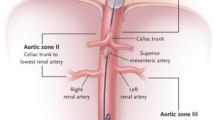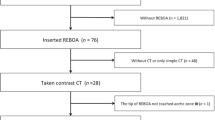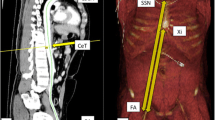Abstract
Purpose
Understanding the vascular morphology is fundamental for resuscitative endovascular balloon occlusion of the aorta. This study aimed to evaluate the effect of aging on length and diameter of aorta and iliac arteries in trauma patients, and to investigate the predictiveness of anatomical landmarks for aortic zones.
Methods
A total of 235 patients in a regional trauma center registry from September 1, 2018, to January 3, 2024, participated in the study. Reconstruction of computed tomography was applied to the torso area. The marginal diameter and length of aorta and iliac arteries were measured. Anatomical landmark distances and aortic marginal lengths were compared.
Results
The length and diameter of aorta and iliac arteries increased with age, and a tortuous and enlarged morphology was observed in older patients. There was a good regression between age and diameter of the aorta. Neither the jugular notch, the xiphisternal joint, nor the umbilicus could reliably represent specific margins of aortic zones. The distance between the mid-sternum and femoral artery (427 ± 25 to 442 ± 25 mm for right, and 425 ± 28 to 440 ± 26 mm for left) was predictive for zone 1 in all groups. The distance between the lower one-third junction of the xiphisternum to the umbilicus and femoral artery (232 ± 19 to 240 ± 17 mm for right, and 229 ± 20 to 237 ± 19 mm for left) was predictive for zone 3 aorta.
Conclusion
Aging increases the length and diameter of aorta and iliac arteries, with a tortuous and enlarged morphology in geriatric populations. The mid-sternum and the lower one-third junction of the xiphisternum to the umbilicus were predictive landmarks for zone 1 and zone 3, respectively.








Similar content being viewed by others
Data availability
The data that support the findings of this study are available on request from the corresponding author, upon reasonable request.
References
Lee G, Kim DH, Ma DS, Lee SW, Heo Y, Jo H, Chang SW. Feasibility and clinical outcomes of resuscitative endovascular balloon occlusion of the aorta in patients with traumatic shock: a single-center 5-year experience. J Chest Surg. 2023;56(2):108–16. https://doi.org/10.5090/jcs.22.105.
Joseph B, Zeeshan M, Sakran JV, Hamidi M, Kulvatunyou N, Khan M, O’Keeffe T, Rhee P. Nationwide analysis of resuscitative endovascular balloon occlusion of the aorta in civilian trauma. JAMA Surg. 2019;154(6):500–8. https://doi.org/10.1001/jamasurg.2019.0096.
Wu YT, Nichols C, Chien CY, Lewis MR, Demetriades D. REBOA in trauma and the risk of venous thromboembolic complications: a matched-cohort study. Am J Surg. 2023;225(6):1091–5. https://doi.org/10.1016/j.amjsurg.2022.11.035.
Wu YT, Lewis MR, Arase M, Demetriades D. Resuscitative endovascular balloon occlusion of the aorta is associated with increased risk of extremity compartment syndrome. World J Surg. 2023;47(3):796–802. https://doi.org/10.1007/s00268-022-06832-2.
Ribeiro Junior MAF, Feng CYD, Nguyen ATM, Rodrigues VC, Bechara GEK, de-Moura RR, Brenner M. The complications associated with resuscitative endovascular balloon occlusion of the aorta (REBOA). World J Emerg Surg. 2018;13:20. https://doi.org/10.1186/s13017-018-0181-6.
Davidson AJ, Russo RM, Reva VA, Brenner ML, Moore LJ, Ball C, Bulger E, Fox CJ, DuBose JJ, Moore EE, Rasmussen TE; BEST Study Group. The pitfalls of resuscitative endovascular balloon occlusion of the aorta: risk factors and mitigation strategies. J Trauma Acute Care Surg. 2018;84(1):192–202. https://doi.org/10.1097/TA.0000000000001711. Erratum in: J Trauma Acute Care Surg. 2018;84(3):544.
Stannard A, Eliason JL, Rasmussen TE. Resuscitative endovascular balloon occlusion of the aorta (REBOA) as an adjunct for hemorrhagic shock. J Trauma. 2011;71(6):1869–72. https://doi.org/10.1097/TA.0b013e31823fe90c.
Stannard A, Morrison JJ, Sharon DJ, Eliason JL, Rasmussen TE. Morphometric analysis of torso arterial anatomy with implications for resuscitative aortic occlusion. J Trauma Acute Care Surg. 2013;75(2 Suppl 2):S169–72. https://doi.org/10.1097/TA.0b013e31829a098d.
Brede JR, Lafrenz T, Klepstad P, Skjærseth EA, Nordseth T, Søvik E, Krüger AJ. Feasibility of pre-hospital resuscitative endovascular balloon occlusion of the aorta in non-traumatic out-of-hospital cardiac arrest. J Am Heart Assoc. 2019;8(22): e014394. https://doi.org/10.1161/JAHA.119.014394.
Eliason JL, Derstine BA, Horbal SR, Wang NC, Holcombe SA, Chiu C-H, Ross BE, Bromwell B, Morrison J, Wang SC. Computed tomography correlation of skeletal landmarks and vascular anatomy in civilian adult trauma patients: implications for resuscitative endovascular balloon occlusion of the aorta. J Trauma Acute Care Surg. 2019;87(1S):S138-S145. https://doi.org/10.1097/TA.0000000000002247.
Wessels LE, Wallace JD, Bowie J, Butler WJ, Spalding C, Krzyzaniak M. Radiofrequency identification of the ER-REBOA: confirmation of placement without fluoroscopy. Mil Med. 2019;184(3–4):e285–9. https://doi.org/10.1093/milmed/usy187.
Linnebur M, Inaba K, Haltmeier T, Rasmussen TE, Smith J, Mendelsberg R, Grabo D, Demetriades D. Emergent non-image-guided resuscitative endovascular balloon occlusion of the aorta (REBOA) catheter placement: a cadaver-based study. J Trauma Acute Care Surg. 2016;81(3):453–7. https://doi.org/10.1097/TA.0000000000001106.
Weng D, Qian A, Zhou Q, Xu J, Xu S, Zhang M. A new method using surface landmarks to locate resuscitative endovascular balloon occlusion of the aorta based on a retrospective CTA study. Eur J Trauma Emerg Surg. 2022;48(3):1945–53. https://doi.org/10.1007/s00068-021-01686-0.
Komutrattananont P, Mahakkanukrauh P, Das S. Morphology of the human aorta and age-related changes: anatomical facts. Anat Cell Biol. 2019;52(2):109–14. https://doi.org/10.5115/acb.2019.52.2.109.
Vatner SF, Zhang J, Vyzas C, Mishra K, Graham RM, Vatner DE. Vascular stiffness in aging and disease. Front Physiol. 2021;12: 762437. https://doi.org/10.3389/fphys.2021.762437.
Redheuil A, Yu WC, Mousseaux E, Harouni AA, Kachenoura N, Wu CO, Bluemke D, Lima JA. Age-related changes in aortic arch geometry: relationship with proximal aortic function and left ventricular mass and remodeling. J Am Coll Cardiol. 2011;58(12):1262–70. https://doi.org/10.1016/j.jacc.2011.06.012.
Sawabe M, Hamamatsu A, Chida K, Mieno MN, Ozawa T. Age is a major pathobiological determinant of aortic dilatation: a large autopsy study of community deaths. J Atheroscler Thromb. 2011;18(2):157–65. https://doi.org/10.5551/jat.6528.
Maleckis K, Keiser C, Jadidi M, Anttila E, Desyatova A, MacTaggart J, Kamenskiy A. Safe balloon inflation parameters for resuscitative endovascular balloon occlusion of the aorta. J Trauma Acute Care Surg. 2021;91(2):302–9. https://doi.org/10.1097/TA.0000000000003276.
Bogert JN, Davis KM, Kopelman TR, Vail SJ, Pieri PG, Matthews MR. Resuscitative endovascular balloon occlusion of the aorta with a low profile, wire free device: a game changer? Trauma Case Rep. 2017;7:11–4. https://doi.org/10.1016/j.tcr.2017.01.006.
Pezy P, Flaris AN, Prat NJ, Cotton F, Lundberg PW, Caillot JL, David JS, Voiglio EJ. Fixed-distance model for balloon placement during fluoroscopy-free resuscitative endovascular balloon occlusion of the aorta in a civilian population. JAMA Surg. 2017;152(4):351–8. https://doi.org/10.1001/jamasurg.2016.4757.
Matsumoto S, Funabiki T, Kazamaki T, Orita T, Sekine K, Yamazaki M, Moriya T. Placement accuracy of resuscitative endovascular occlusion balloon into the target zone with external measurement. Trauma Surg Acute Care Open. 2020;5(1): e000443. https://doi.org/10.1136/tsaco-2020-000443.
Olsen MH, Thonghong T, Søndergaard L, Møller K. Standardized distances for placement of REBOA in patients with aortic stenosis. Sci Rep. 2020;10(1):13410. https://doi.org/10.1038/s41598-020-70364-9.
Rusu MC, Jianu AM, Manta BA, Hostiuc S. Aortic origins of the celiac trunk and superior mesenteric artery. Diagnostics (Basel). 2021;11(6):1111. https://doi.org/10.3390/diagnostics11061111.
Attwell L, Rosen S, Upadhyay B, Gogalniceanu P. The umbilicus: a reliable surface landmark for the aortic bifurcation? Surg Radiol Anat. 2015;37(10):1239–42. https://doi.org/10.1007/s00276-015-1500-1.
Vrancken SM, Borger van der Burg BLS, Vrancken PJEM, Kock GH, Rasmussen TE, Hoencamp R. A contemporary assessment of devices for resuscitative endovascular balloon occlusion of the aorta (REBOA): resource-specific options per level of care. Eur J Trauma Emerg Surg. 2021;47(1):57–69. https://doi.org/10.1007/s00068-020-01382-5.
Johnson MA, Neff LP, Williams TK, DuBose JJ; EVAC Study Group. Partial resuscitative balloon occlusion of the aorta (P-REBOA): clinical technique and rationale. J Trauma Acute Care Surg. 2016;81(5 Suppl 2 Proceedings of the 2015 Military Health System Research Symposium):S133-S137. https://doi.org/10.1097/TA.0000000000001146.
Mulayim B, Gurses C, Karadag B, Sozel YK. The relationship between the umbilicus and the aortic bifurcation in Turkish women: implications for laparoscopic entry. Arch Gynecol Obstet. 2017;296(6):1175–80. https://doi.org/10.1007/s00404-017-4552-0.
Kluck SL, Russo RM, Appel NB, Frankfurt AI, Weltge C, Shimer T, Feagins B, Frotan A, Rinehart B, Cohen RA. Aortic balloon occlusion in distal zone 3 reduces blood loss from obstetric hemorrhage in placenta accreta spectrum. J Trauma Acute Care Surg. 2023;94(5):710–7. https://doi.org/10.1097/TA.0000000000003917.
Nakajima K, Taniguchi H, Abe T, Yamaguchi K, Doi T, Takeuchi I, Morimura N. Does the conventional landmark help to place the tip of REBOA catheter in the optimal position? A non-controlled comparison study. World J Emerg Surg. 2019;14:35. https://doi.org/10.1186/s13017-019-0255-0.
Funding
This study was funded by the Health Commission of Shenzhen Nanshan District (NS2022122).
Author information
Authors and Affiliations
Contributions
R-F. L. designed the study protocol, collected data for all subjects, and wrote the main manuscript text. X-F. G. re-checked the measurements independently and contributed to the statistical analysis. H-B. X. set up the statistical analysis scheme and grouping method. J-T. L. and H-G. Z. prepared Figs. 1, 2, 3, and 4. Z-J. S. prepared Tables 4, 5, 6, and 7. All authors reviewed the manuscript.
Corresponding author
Ethics declarations
Conflict of interest
The authors declare no competing interests.
Rights and permissions
Springer Nature or its licensor (e.g. a society or other partner) holds exclusive rights to this article under a publishing agreement with the author(s) or other rightsholder(s); author self-archiving of the accepted manuscript version of this article is solely governed by the terms of such publishing agreement and applicable law.
About this article
Cite this article
Li, Rf., Gong, Xf., Xu, Hb. et al. Age affects vascular morphology and predictiveness of anatomical landmarks for aortic zones in trauma patients: implications for resuscitative endovascular balloon occlusion of the aorta. Eur J Trauma Emerg Surg (2024). https://doi.org/10.1007/s00068-024-02512-z
Received:
Accepted:
Published:
DOI: https://doi.org/10.1007/s00068-024-02512-z




